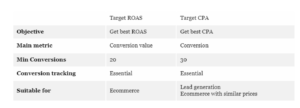Target ROAS is a great bidding strategy to use in your Google ad campaigns when other foundational factors like your website speed, proper keyword optimization etc are taken care of.
So in this article, You’ll what Target ROAS is, when you should use it, and how to avoid common mistakes that will break things.
What exactly is Target ROAS Bidding?
Target ROAS is a Google Ads bid strategy that aims to achieve the advertiser’s specified target return on ad spend.
Return on Ad Spend (or ROAS in the rest of the article) is the conversion value you receive for every dollar you spend on ads.
The following formula is used to calculate ROAS:
ROAS = (Revenue / Ad Spend) multiplied by 100
So, if your campaign spends $50 to generate $100 in revenue, the ROI is 200 percent:
$100 divided by $50 multiplied by 100 equals 200 percent.
Because your entire bidding strategy is based on ROAS, it’s critical to understand what it is and isn’t.
ROAS may sound similar to ROI, but there are some key differences. When calculating ROI (= return on investment), you take into account all costs, not just ad spend.
So, while a ROAS of 1500 % may appear impressive on the surface, this advertiser may be losing money.
That is why it is critical to understand business economics and be able to translate business objectives into things like ROAS targets.
Is Google removing Target ROAS Bid Strategies?
Google announced in March 2021 that two of its oldest automatic bidding strategies, Target CPA (Cost per Acquisition) and Target ROAS, would be phased out. If we assume that these strategies will be phased out indefinitely. This is not correct! Target CPA and Target ROAS are and will remain available, but not as the primary bidding strategy. Instead, they will be available as options within the Max Conversions and Max Conversion Value strategies.
Here’s a table that compares the old and new:
When creating new bid strategies for Search campaigns, advertisers will now see the following options, according to Google:
Maximize conversions will include a target CPA as an option.
Maximize conversion value will have a target ROAS that is optional.
This update only affects campaign-level strategies; portfolio bid strategies will be updated at some point next year.
Google has clarified that this update will have no effect on bidding behavior. When using Maximize conversions with a target CPA, the bidding behavior will be the same as when using Target CPA. Similarly, using Maximize conversion value in conjunction with a target ROAS will result in the same bidding behavior as Target ROAS.
It will be a gradual change, similar to other recent changes in Google ads released this year. Unlike other changes released this year (such as the inclusion of the Broad Match Modifier in Phrase Match), there isn’t much to do. This is simply a reorganization of existing features. However, it will not hurt to be cautious and proactive.
Check out this video by Paid Media Pros for a better understanding
How To Set up a Target ROAS Bid Strategy In Your Account
- In the page menu on the left, click Campaigns.
- Select the campaign you want to edit.
- Click Settings in the page menu for this campaign.
- Open Bidding and then click Change bid strategy.
- Choose Maximize conversion value and Select Target ROAS from the drop-down menu.
- Click Save.
How Does Google Ads Target ROAS Bidding Work?
In its most basic form, Target ROAS works as follows:
Target ROAS raises CPCs for clicks with a history of being valuable while decreasing CPCs for others.
That may sound familiar if you’re familiar with how Enhanced CPC works.
However, unlike Enhanced CPC, Google controls the entire bid with Target ROAS, whereas the former is much more limited.
Google can keep a tight grip on the cost side of things by controlling the bid that goes into the auction and having a pretty good idea of where the actual bid will end up.
The expected revenue estimate associated with each click is on the other end of the algorithm.
They’re able to estimate the expected revenue for each click by mining through all available data (what they have from your account, but also what data they have on users).
Target ROAS is the result of combining the two.
It’s important to remember that this is the average ROAS for this campaign, so you won’t see it if you look at a single sale or even a single day. However, the true ROAS should be reflected across sales and over multiple days or weeks.
When Should You Use Target ROAS?
Target ROAS bidding is available for Search, Shopping, and Display campaigns.
The most important requirement for using it effectively is a sufficient amount of conversion data.
For campaigns on the Search and Display networks, the minimum requirement is 15 conversions in the last 30 days, and for Google Shopping campaigns, the minimum requirement is 20 conversions in the last 45 days.
To maximize the efficiency of this bidding strategy, Google recommends at least 50 conversions in the last 30 days.
To be clear, these are conversions per campaign, not for your entire account.
As a result, it is clear that in order to use Target ROAS, you must have a large number of sales. As a result, I always recommend starting with a more basic bid strategy, such as Manual or Enhanced CPC.
This allows you to accumulate the necessary conversion volume while also gaining an idea of what target ROAS you can actually achieve.
Target ROAS Expectations
Now that you have a better understanding of how Target ROAS works, I’d like to dispel the most common myth about this bid strategy.
Target ROAS isn’t a magic wand; just because you set the ROAS to a certain value doesn’t mean you’ll be able to hit it.
Google cannot hit the target if your campaign has structural flaws.
Google cannot hit the target if your products or website perform poorly.
Consider the following scenario: if your campaigns have been returning a ROAS of 489 percent using Manual CPC as a bidding strategy, there is no way they can suddenly reach a ROAS of 900 percent:
After ensuring that all of the other components are functioning properly, you can use the automation to decide bids, often reducing your day-to-day workload.
This may all seem obvious, but you have no idea how frequently I come across this issue in my account audits.
People will set it to a value they’ve never been able to achieve before, and Google will make it happen.
Optimizing Target ROAS Campaigns
Any PPC campaign or bidding strategy, smart or not, necessitates close attention to detail. Otherwise, it will not run optimally, limiting your potential returns.
Our campaign has been created, but it still needs to be optimized.
Examine your margins: Some businesses may be fortunate enough to come across industry-specific benchmark data for determining how to set a Target ROAS objective.
To avoid setting the incorrect ROAS percentage for your campaign, it is important to review your own margins.
This figure should be evaluated for each campaign by taking a close look at the products and services you’re offering in those ads. What are the margins for those products/services, and where does your ROAS need to be in order to profitably?
Divide campaigns into smaller ad groups: You want to segment your campaigns based on similar products and services. You should also divide highly successful campaigns into smaller ad groups. This will allow you to better target the reasons for those winning advertisements.
Then you can apply those insights to better target audiences and get even better results.
Pay close attention to the volume of conversions and their returns as you complete this step. To inform these decisions, you should use data from previous campaigns and bidding strategies.
Allocate budget based on profit: Measuring ROAS is an excellent way to determine where and how to allocate your advertising budget.
Assume your ROAS across Search Network campaigns is 3.64, which means you’re getting $3.64 back for every dollar you spend on the Search Network. Display ads, on the other hand, are promoting a much higher return at $4.50 per dollar spent.
This is a strong indication that you should increase your spending on the Display Network. It’s all about rearranging the pieces and figuring out what works and where the value is.
Best Practices for Improving Target ROAS Campaigns in General
Campaigns using the Target ROAS bidding strategy may have a different end goal in mind, but they function in the same way as the rest of your pay-per-click advertising efforts. As a result, they benefit from many of the same PPC best practices.
All of these are general tips that any digital marketer or PPC advertiser can use. They will also have a positive impact on your Target ROAS efforts.
Make Your Website Mobile-Friendly
Mobile devices (such as smartphones) have altered the way consumers shop.
Your target audiences use these tools at every stage of the buying process, whether it’s to research products, compare prices, find the best deals, find discounts, or make a final purchase.
This means that many of the clicks and conversions for Target ROAS campaigns are coming from mobile devices. If your ROAS is suffering, don’t immediately blame it on bad keywords or poor campaign optimization.
It could be a case of insufficient mobile optimization.
If your site doesn’t perform well on mobile devices in terms of loading time and user experience, there’s a good chance that these customers will leave.
There are several ways to enhance your mobile experience:
- Remove any clumsy scripts or content assets that are overburdening the page.
- Make use of location-based services to help personalize the page based on the user’s location.
- Use mobile-friendly design elements (such as “see more” buttons).
- Remove any extraneous steps from the checkout process.
- Check that all of the information displays correctly, whether you’re browsing vertically or horizontally.
Many of these steps will also help your mobile users’ load times.
Monitor Competing Strategies
We’re taught in elementary school not to copy our classmates’ answers. It is, however, encouraged in digital marketing.
Understanding your competitors’ strategies and tactics is critical to your own success. It enables you to see the other pieces on the board and how your strategies can be aligned to counteract their activities.
It’s also a great way to learn about your own campaigns. This is an essential strategy for newer advertisers who may lack historical data to guide campaign-related decisions or devise successful bidding strategies.
You can “spy” on the competition and how they approach their own PPC efforts using both paid and free tools. Examine their ad copy, CTAs, and other assets. Some tools even allow you to see which keywords your competitors are focusing on!
Long-term trending tools are especially useful because they allow you to make data-driven decisions about which competing ads are the most successful.
If a competitor has been running an ad for a long time, you can assume that it is producing good results.
You can approach your competitors’ PPC strategies in two ways:
Use their efforts as a source of inspiration for your own: This is why we say analyzing the competition is essential for new businesses. You may not only lack the historical data required for accurate decision-making, but you may also lack an understanding of how to attract and entice your target audience. Adopting some of their strategies as your own is a quick fix.
Look for alternative ad opportunities: The more you know about your competitors, the clearer your vision of the PPC sandbox in which your company operates. You may be able to counter-strategize if you know where your competitors are concentrating their efforts. This could imply focusing on less competitive keywords, emphasizing different product benefits, or addressing an underappreciated point of contention among target consumers.
Exquisite Landing Page Experiences
When your campaigns attract clicks but fail to convert, this is a major source of concern for campaign managers. You’re spending money on those clicks but getting no results. This is a clear indication that your landing pages are deficient.
Many inexperienced PPC managers make the mistake of using the same landing pages across multiple campaigns. This is a stumbling block because each campaign targets a different audience and highlights different products, deals, and so on.
Just because your landing page performed well in a previous campaign or with a specific audience segment does not imply that it will perform well in the future.
If you’ve included an offer in your ad, make sure it’s visible on the landing page. That offer is almost certainly the sole reason they clicked in the first place! You should also utilize the same style, tone, and language on your landing page and ad.
If your ad and landing page do not look, feel, and sound the same, it will create a disconnected experience.
Expert advertisers test their landing pages often and make tiny changes over time to guarantee that they are maximizing outcomes.
Keywords!
A discussion of PPC would be incomplete without a lengthy section on keywords. These keywords will largely determine the overall success of any campaign
Keywords are equally important in Target ROAS campaigns. Keywords lead to conversions, and conversions have a direct impact on how much we spend and what we get in return.
There’s a lot to consider when evaluating your keywords.
Purchase Intent: Keywords that directly relate to the desired action of your campaign, whether it’s a purchase, reservation, subscription, or something else, should always be high-value targets. These keywords indicate potential leads who are prepared to convert. “Buy khaki pants,” “free shipping on TVs,” and “sports store near me,” for example. All of these searches indicate that the person is looking for an immediate solution.
Keywords with a high spend but no conversions: This is a dead giveaway that something is wrong with your campaign. These keywords may not have the same level of purchasing intent as other terms in the same campaign. Alternatively, it could imply that there is a mismatch between these keywords and the resulting landing pages.
If you can’t come up with a solution, you might want to add these words to your list of ‘negative keywords.’ This will prevent your ads from appearing when users search for these terms. As a result, the Smart Bidding technology will no longer waste valuable budget on terms that do not convert.
Relevance: You want people to click on your ads because they are genuinely interested in converting. When irrelevant keywords enter your campaigns, it can not only cost you money in bad clicks, but it can also harm your Quality Score and future ad rank.
You should also pay attention to where your ads are targeting, especially if you own a physical store or an eCommerce business that only ships to specific areas.
Target ROAS vs. Target CPA
The goals of target ROAS and target CPA are very similar.
Both are automated bidding strategies, but while target CPA focuses on the number of conversions, target ROAS also considers the value of the conversion.
Target CPA may be a good fit if your goal is to get as many conversions as possible for a specific cost. This is frequently used to generate leads. Target CPA can also be useful in eCommerce if your average order value does not vary greatly between products.
If there is a significant price difference between products, Target ROAS is a better bidding strategy.
Both bidding strategies have the same requirements: conversion tracking must be set up and a certain number of conversions must be achieved.
How to Make the Most of Target ROAS
Targeting ROAS can be an excellent bidding strategy for eCommerce companies.
It can automate what is working well and probably do so more efficiently.
However, it will not magically solve other issues with your campaigns.
When making the switch, it’s critical to set realistic return and spending targets. Otherwise, you run the risk of starving your campaigns and losing valuable traffic.
Having more conversion data before making the switch, as well as segmenting your campaigns if you expect different ROAS performances, can help you get better results.
If you make a significant change, your campaigns will go through a learning phase, as with all of the Smart Bidding options. This may cause changes in performance, but your campaigns should emerge stronger as a result. Let’s help you run profitable Facebook and Google ads to get you an awsome results whether that’s leads or sales.







